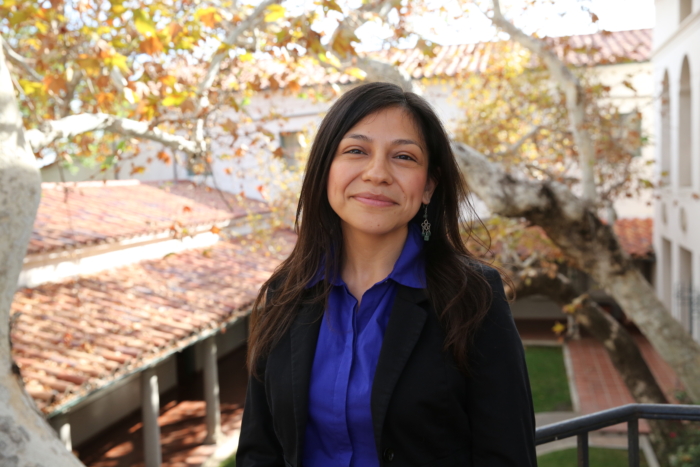
This fall, 11 new tenure-track faculty members joined Scripps College. As part of our ongoing series on Scripps’ faculty, the Office of Marketing and Communications recently sat down with Gabriela Bacsan, who joins the College as Assistant Professor in the department of Spanish, Latin American, and Caribbean Literatures and Cultures.
Bacsan earned her B.A. in Spanish and Latin American Literatures and Political Science at UC Berkeley. She completed her M.A. and Ph.D. in Literature, with a specialization in Latin American Cultural Studies, at UC San Diego. Her fields of interest are Caribbean studies, transnational and intersectional representations and conceptualizations of queerness in Latin America, historical memory studies, critical geographies, and tourism studies. Bacsan’s research centers on Cuban literatures and cultures with a focus on the intersections of gender, race, and sexuality. One of the articles she is currently preparing for publication examines the Cuban Ministry of Tourism’s current marketing campaign, focusing specifically on how gender, race, and authenticity are deployed to sell the island as paradise.
Scripps College: What sparked your interest in Cuban literatures and cultures?
Gabriela Bacsan: I had the opportunity to study abroad in Cuba as an undergraduate. During these deeply immersive six weeks in Havana, I was able to learn firsthand about its authors, artists, economy, and politics—it had a significant impact on my academic formation! When I got back to Berkeley I sought classes in Cuban literature, cultural studies, and history that allowed me to delve deeper into the interrelated issues important to understanding more about how historic events influence the present and the people of Cuba. Ultimately, that led to my doctoral scholarship and post-doctoral work that informs my first book, currently in development, which examines how contemporary cultural productions by Cuban women both within the island and in the diaspora explore and challenge contemporary transformations of urban space, the effects of migration, and the implications of post-soviet subject formation of Cuban womanhood in Havana since the 1990s.
SC: Can you tell us more about the emergence of women writers and artists in the post-soviet era of the 1990s in Havana?
GB: Following the collapse of the Soviet Union, Cuba entered a time of severe economic hardship that was termed “The Special Period in Times of Peace.” Decisions made by the Cuban government to bolster the economy during that time fueled the growth of a formal tourism industry. The reintroduction of tourism was perceived as a “necessary evil” for economic survival. Yet, while tourism did in fact become an effective strategy for economic development during the Special Period, the resurgence of foreign tourists on the island also led to increased social conflicts and economic disparities. Perhaps the most significant is the emergence of jineterismo, which encompasses both sex work and informal sexual and non-sexual relationships whereby local Cubans benefit from foreign tourists.
However, during that time of economic hardship the island also experienced a surge in its cultural production. What is most interesting to me is the increase in narrative production by Cuban women, many of whom did not previously identify as writers. In my interviews with Cuban women who began writing during the 1990s, they highlight that it was the context of the Special Period that led them to write short stories as a way to chronicle their experiences. What is remarkable is not only that there was an increase in Cuban literary production by women, but rather the topics on which they focused and the narrative structure of their texts. Many of those topics, including sexuality, eroticism, and domestic violence, for example, had been considered taboo. Importantly, through their works, Cuban women writers brought attention to both the material dimensions —such as food shortages, lack of transportation, and urban displacement— and the affective dimensions —such as internal moral crises, changing relationships among Cubans, and ideological displacement— of the economic crisis. The narrative production by Cuban women writers thus sparked important debates, both at the formal academic level as well as at the interpersonal level among Cubans, regarding the past, present, and future of the Cuban Revolution amidst the crisis.
SC: What classes are your teaching at Scripps, and what do you look forward to teaching?
GB: Currently, I am teaching an intermediate Spanish language class, and an upper division Latin American literatures and cultures class that focuses on the city in Cuba and Chile. I am excited about teaching in Core next year. I look forward to teaching a Core 2 class that engages students with topics of intersectionality transnationally to help us explore the implications of colonialism and globalization, and challenge structures of oppression.
SC: Is there a fact about yourself that is surprising, or that people don’t know about, that you’d like to share?
GB: I enjoy live music very much. I have been an avid concert goer since I was in my early teens. To me, hearing a song I love played live can be a transformative experience.

